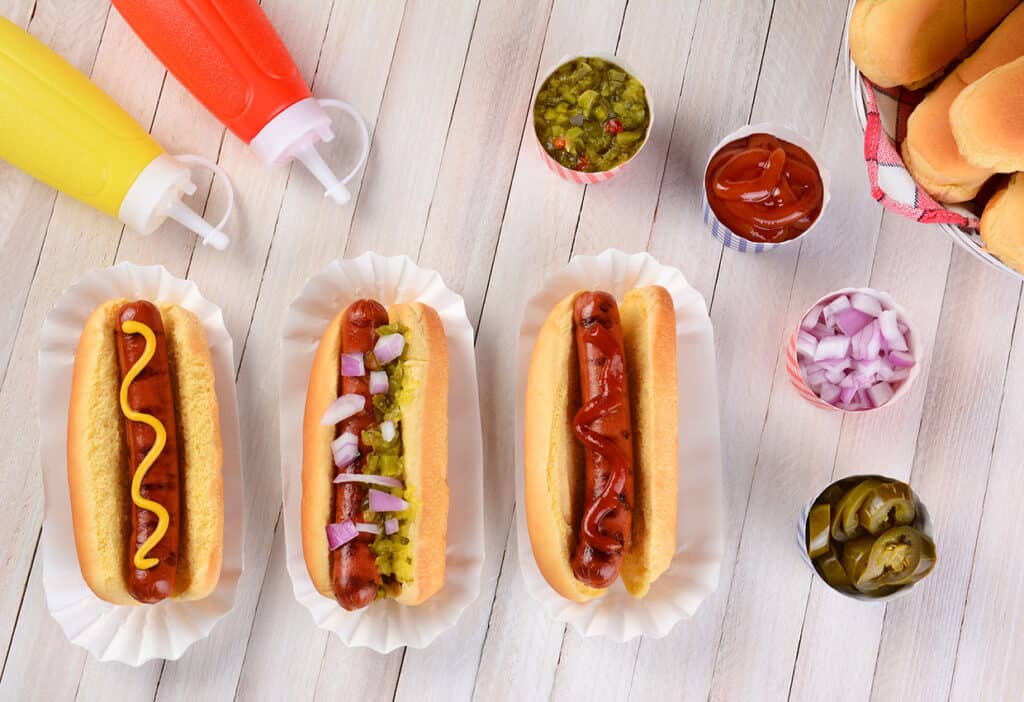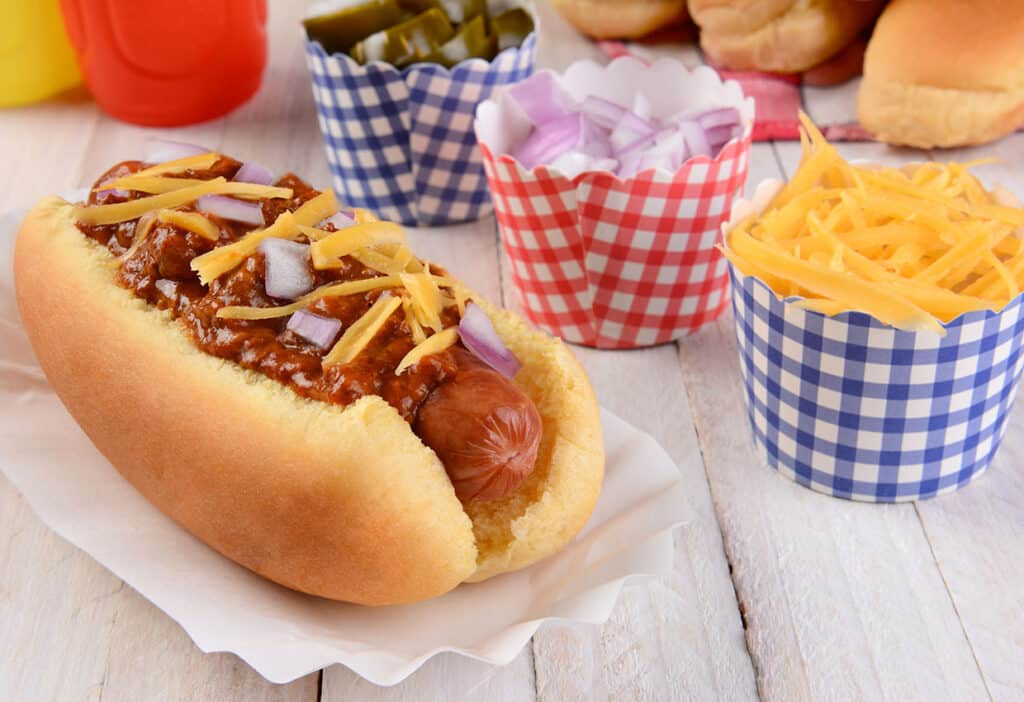Sure, a big fat steak is enticing, but both kids and adults will smash down a properly cooked and topped hot dog.

With summer on the horizon, backyard grills will soon be loaded up with hamburgers and hot dogs and ballpark vendors will be walking the aisles peddling the classic meat treat.
Grab a napkin, loosen your belt and prepare to rediscover the delicious world of hot dogs, from all the varieties to choosing the ideal bun and creative toppings.
Quick hot dog history
Sausages have been around for centuries. They are made by stuffing minced meat, fat and seasonings into a casing. This process was a great way to use up meat trimmings that weren’t ideal for large cuts like steaks or chops.
The process evolved in Europe and instead of just using minced meat, butchers began processing the meat even further into what became known as frankfurters and Vienna sausages.
This culinary technique migrated to the United States and evolved once again. Today, American hot dogs are made by pureeing ground beef, pork and poultry with food starch, salt, seasonings, sweeteners and water.
The paste is stuffed into casings and introduced to heat, smoke and more salt. Once fully cooked, the casings are removed, and they’re traditionally sold in packs of 10 along with an 8-pack of buns.
According to the National Hot Dog and Sausage Council, Americans consume an estimated 20 billion hot dogs every year.
Hot dog varieties
Hot dogs are made using a variety of meat trimmings.
Oscar Mayer Original Wieners are made with a combination of turkey, chicken and pork, but they also have all-beef, all-turkey and all-chicken varieties. They even offer cheese dogs, which are made with turkey, chicken, pork and cheddar cheese.
Ball Park Brand Franks also offers options. Their original franks contain chicken and pork. They carry all-beef franks, made with prime beef or Angus beef, and they have turkey franks made with white and dark meat or just white meat.
The entire lineup of Nathan’s Famous Hot Dogs and Hebrew National Franks is 100 percent beef. You can also find gourmet specialty hot dogs from retailers like Snake River Farms. Their hot dogs are made from 100 percent American Wagyu beef.
If you prefer for your hot dog to only contain meat cut from primal muscles, look for labels that say no by-products. If the label says “with byproducts” or “with variety meats,” the hot dog may contain meat organs like heart, kidney or liver.
With the rise in vegetarian and vegan diets, it’s now easier to find veggie or plant-based hot dogs made from ingredients like tofu, wheat gluten, pea protein or a combination of vegetables.
Just because a hot dog is made of turkey or veggies doesn’t mean it’s lower in calories or fat.
Virtually all hot dogs contain fats or oils and seasonings to enhance the flavor. Be sure to read the labels.
Hot dogs also often include additives to improve their texture, appearance and shelf life.
These additives may include curing agents like sodium nitrite or sodium erythorbate to preserve the color and prevent bacterial growth. They may also include stabilizers, emulsifiers or fillers to give the hot dog a consistent texture and prevent separation of ingredients.
When hot dogs and sausages are formed, they are extruded into casings to hold their shape. Many commercially produced hot dogs, especially vegan varieties, use artificial casings made from cellulose, algae or other materials. Although more common with sausage, sometimes animal intestines are used.
Most of the time, the casings are removed after the hot dogs are cooked and before they are packaged, but some brands tout that they leave the casing intact, because it provides an authentic firm bite and snap.
Grilling vs. other cooking methods
Hot dogs are fully cooked before they are packaged, but the USDA does recommend reheating them, especially for those at an increased risk of foodborne illness. So what’s the best way to cook a hot dog?

Simmer or boil
If you love the hot dogs from pushcarts in New York City, try cooking your next round of hot dogs in a pot of hot water, but not just any water — dirty water.
The water isn’t actually “dirty.” It’s just not clear, because it’s flavored with seasonings like onion, vinegar, ketchup, cumin and salt.
Place the pot on the stove, fill it halfway full of water and add the seasonings. Once the water is simmering, drop in the dogs and let them heat up.
It only takes a couple of minutes to boil a hot dog, but for the best flavor, let them simmer for a good 30 minutes. Then, take them out and nestle them on a soft bun.
FDL’S 75 Best Bites

Our cookbook with 75 tasty recipes will be your go-to kitchen companion for easy dinners with ad-free recipes right at your fingertips. Crafted by experienced chefs and recipe developers, this collection offers a treasure trove of tried-and-true dishes that make mealtime a breeze.
Get the Recipe: FDL’S 75 Best Bites
Grilled
If you prefer a little char on your hot dog, grilling over direct heat is the way to go. You can grill hot dogs outdoors on a charcoal, gas or pellet grill. Or grill them indoors on a Ninja or George Forman grill or grill pan.
Heat your grill to high and add the dogs to the grates or pan. As they start to form grill marks, rotate them and continue cooking until you get the char you like.
Smoked
For more smoke and less char, heat your hot dogs slowly on the grill or smoker over indirect heat. Add charcoal or pellets to your smoker and set the temperature to 250 F degrees.
Then, place your hot dogs in the smoker and cook them for 45 minutes to an hour, until they’re heated to about 160 F degrees.
Pan frying
No grill pan. No problem.
Hot dogs can be cooked in a regular skillet, too, just like a smashburger (without the smash). Add a drop of oil to the pan, heat it to high and let your hot dog sizzle until warmed through.
Microwaving
When you’re really in a hurry, the easiest way to reheat a hot dog is in the microwave. This method doesn’t impart any added flavors like simmering and grilling, but it is quick.
Simply place a couple of franks on a plate. Cover with a paper towel and heat them at 30-second intervals until warmed through.
The perfect hot dog bun
Why are there eight hot dog buns in a pack, when you get 10 hot dogs? The world may never know, but the perfect hot dog bun is one that’s soft, warm and proportionate in size to the hot dog itself.
Classic hot dog buns are similar to white bread. They’re made with white flour, water, corn syrup and yeast.
Nowadays, you can also find potato buns made with potato flakes, whole wheat buns, brioche bun, butter buns and even sweet Hawaiian buns and vegan buns.
When choosing a bun, select a variety that matches your dietary needs and complements the flavor profile for your toppings.
To heat them, wrap the buns in foil and place them in a warm oven or over indirect heat on the grill. You can even microwave them in a paper towel for a few seconds.
For soft buns, spritz them with a little bit of water to help steam them. For crispy buns, brush the inside with butter and toss them on the grill or under the broiler.
Not all hot dogs have to be served on buns. The ever-popular corndog is a frankfurter skewered on a stick that’s dipped in cornmeal batter and deep fried. It’s often served with ketchup and mustard and is popular at ballparks, carnivals and fairs.
Creative hot dog toppings and condiments
When throwing a backyard BBQ, it’s best to offer squeeze bottles of ketchup, mustard, pickle relish and mayonnaise.
If you want to elevate the party, consider making homemade pickles or aioli or offer gourmet ketchups and mustards.

For a chili dog party, set out a large bowl of chili along with diced onions and shredded cheese. Or consider offering toppings that create an international fusion experience like birria beef and Mexican street corn or beef bulgogi and kimchi.
Here are a few other regional specialties from across the world.
Chicago-style hot dog
A classic Chicago-style hot dog starts with a beef frankfurter served on a poppy seed bun. It is topped with yellow mustard, chopped onions, dill pickle spears, tomato slices, sport peppers and a sprinkle of celery salt. It wouldn’t be complete without the bright green sweet pickle relish.
New York-style hot dog
A New York-style hot dog typically features a beef frankfurter on a steamed bun, topped with yellow mustard, sauerkraut and a thin, tangy onion sauce.
Detroit Coney Island dog
The Detroit Coney Island dog is topped with a meaty chili sauce, known as Coney sauce, that’s made with ground beef, onions, tomato paste and spices. It’s finished with mustard and diced onions and served on a steamed bun.

Sonoran hot dog
The Sonoran hot dog hails from the Sonoran region of Mexico and is popular across the Southwestern United States. It starts with a bacon-wrapped frankfurter that’s grilled until crispy and served on a soft bolillo roll. Common toppings include pinto beans, diced tomatoes, onions, mayonnaise, mustard, jalapeño sauce and a sprinkle of Mexican spices.